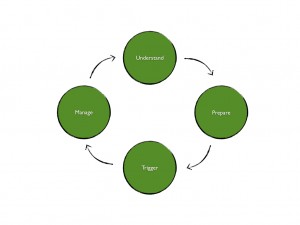The Agile community talks a lot about “agile failure” and I’ve seen more than enough debates about “doing vs being Agile” to want to shoot myself, but what about failure of change initiatives? Let’s face it, Agile is simply a trigger for change, not a destination.
Change efforts have a lousy success record according to this article. Here are the success percentages with respect to change initiatives from the article to save you some time.
1995 – Kotter: 30%
1998 – Turner and Crawford: 33%
2005 – Procsi: 29%
2008 – Mckinsey: 30%
2011 – Standish Group: 34%
At the Toronto Agile Tour this past Monday (Nov 26), Andrew Annett and I presented “Managing Resistance to Change” and our desire was to change that to “Managing Responses to Change”. The important distinction is that people do not “resist” change.
What we label as “resistance” is simply a response from someone who, for a variety of reasons, doesn’t understand the need for the change. I won’t go into details for the purposes of this post, but obviously it’s more complex than that.
Is there a better way to manage change? Can you actually manage change? The metaphor I like to use is about managing the ensuing chaos after the change, not necessarily “managing the change” itself.

I want to keep this post at a high level of developing a more cohesive change management strategy. Given the article I mentioned talked about lack of structured change management process and a simplistic view of human behaviour as the two major factors, I think this approach to creating a change strategy addresses both.
1) Understanding Change: Learn about the Satir Change model, Interaction model and Human Validation Process model. This will prepare change agents for what to expect from people and teams. Along with understanding how people process change, I’ve run sessions that map MBTI temperaments and function pairings on top of the Satir change model. As a quick example, someone with a Guardian (SJ – Sensing, Judging) preference will appear to be resistant when change is pushed on them. They rely on past experiences and value stability, hierarchy and process. You can also use models like SCARF and the Fogg Behaviour Model to understand the human behaviour side of change.
2) Prepare for Change: This is where classic change management comes into play. Using the ADKAR tool (awareness, desire, knowledge, ability, reenforcement) , collect data and filter by layers of hierarchy, teams and departments to paint a picture of where trouble spots may lie. For example, you could discover that the “Ability” score is low meaning that more time may be needed to support people through the change. You may also find out that certain teams, groups or people have lower desire to change than others. This data will help you figure out your change strategy. There are other methods like interviews, walking through Kotter’s 8-step change model, cultural assessments (William Schneider) and more.
3) Trigger the Change: For this post I’ll use an Agile Transformation. Depending on what data emerges from step 2, the trigger may be a manager training program for example. You may discover there is no desire to change and stop the initiative altogether.
You could use “Agile Transformation” as the trigger or “Agile Adoption” as the trigger or the 4 Disciplines of Execution. There are many more triggers depending on what problem you’re trying to solve with the change.
4) Manage the Response: We’ve been experimenting with using Lean Startup techniques (Lean Change) to manage introducing change into organizations. Lean Startup shortens the feedback loop as much as possible, allows you to validate the “minimum viable changes” before introducing them and involves the people affected by the change earlier.
During this step you’ll see your organization move from complex to chaotic and you won’t be able to predict how people will respond and naturally, those who struggle with the change will be labelled as resisters. This is where it’s important to put reenforcing structures in place to help people elevate themselves into the new status quo.
Using Management 3.0, Speed of Trust, complexity thinking, systems thinking, 5 Dysfunctions of a Team and other frameworks can help people learn new techniques for managing this chaos. I suppose this could fit into ‘Prepare for the Change” but I’d prefer to wait until I’ve poked the bear before spending too much time, money and effort over-planning for a reaction you cannot possibly predict.
I haven’t mentioned the other hoards of models and instruments that can be used during these stages. All I know is there are enough models and thoughts from the change management world that can merge with the ideas in the Agile community to help organizations evolve into organisms that can adapt to their constant changing environments.
Stephen Hawking said that we are entering the age of complexity and the average life expectancy of corporations has shrunk from 70 years (1938) to 15 (2010). Organizations that learn how to adapt will survive. Organizations that don’t will die.
There must be a better way to help organizations learn how to change. I’d love to hear your feedback and thoughts about how we can bridge the gap between change management and “Agile” and start focusing on fixing real problems.